Advertisement
BoatUS explores the ways modern, large-scale boatbuilders harness the newest technology and successfully balance innovation with the tried-and-true.

Robots! These five-axis routers (above) are accurate to 1/8000th of an inch. In this cutting booth, the robots cut the hole for the sterndrive — a place where accuracy and alignment are critical. (Photo: Sea Ray)
When we think of the word "technology," most of us think of complex innovation that changes our lives. But when it comes to boatbuilding, while we may appreciate novelty and innovation, what we require as a first priority is reliability and good value. Many of the largest boat manufacturers in the United States have been successfully embracing cutting-edge technologies in their building operations while creating a new generation of boats more modern, stronger, and efficient than their forbears. BoatUS decided it was time to pull back the curtain and see how modern, large-scale production plants build boats these days, using everything from 3D designs, space-age materials, and even robots. There were several top American boatbuilders we could have selected to study today's cutting-edge building innovations. But to make our choice clear-cut, we chose to visit America's largest builder to learn how modern innovation marries with tried-and-true techniques that have been honed over more than seven decades of composite boatbuilding.
An Inside Look at One Large-Scale Builder
Sea Ray describes itself as "the world's largest manufacturer" of pleasure boats. Founded in 1959 by Cornelius Ray, Sea Ray was an early pioneer in fiberglass-reinforced plastic (FRP) boat construction. In 1986, the Brunswick Corporation acquired Sea Ray; last year, Brunswick reported $3.8 billion in sales, of which $1.14 billion came from its boat group, including Bayliner, Meridian, Boston Whaler, and builders of aluminum and pontoon boats.
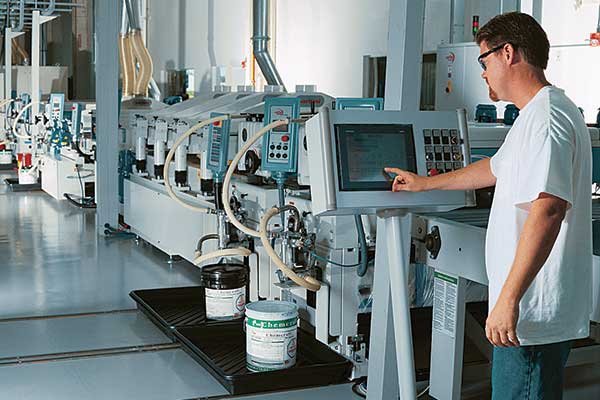

Computer-aided manufacturing (CAM) provides a seamless connection from precise 3D designs to fully formed parts. In today's Sea Rays, the technology is in the details — designed social spaces forward, joystick controls, and lighter structures. (Photos: Sea Ray)
Today, Sea Ray builds 40 models, ranging from 19 to 65 feet, at two plants: small boats near Tellico Lake, Tennessee, and large boats in Palm Coast, Florida. Brunswick also owns the engine manufacturer Mercury Marine, which generates half of the company's sales and provides technical support to Sea Ray's designers.
The Design Process
Sea Ray does most of its design work at its Product Development & Engineering plant at Sykes Creek, on Merritt Island, Florida — also where all tooling is created. Many large-scale builders, such as Brunswick, Beneteau, and others, design boats with software in 3D so they see problems, find solutions, and build repeatability and accuracy into the construction process, even before the tooling is created. This has been a game changer.
Rapid prototyping with CAD, CFD, and FEA software
"Twenty years ago," said Ron Berman, vice president of Sea Ray's product portfolio, "designers usually started with sketches on paper." All the early conceptual designs for a new model were 2D hand-drawn sketches. "Designers still sketch," he said. "You're not going to replace the interaction of the hand with a cursor or pencil or pen. But now they do it on a tablet, and it's all in the computer."
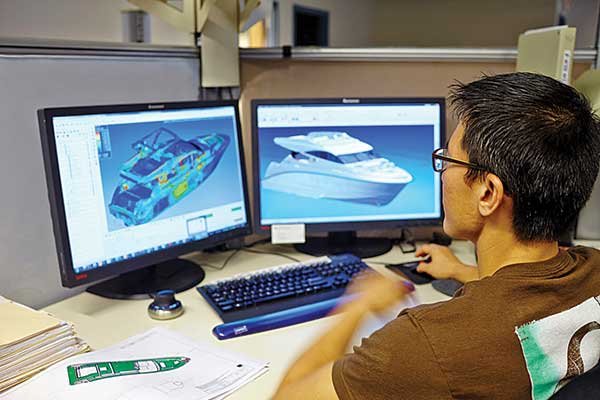
Sea Ray's designers, with support from Mercury Marine, create a hull form using CAD, CFD, and FEA digital tools. Once the hull form is designed, five-axis milling machines cut the exact shape from polystyrene or polyurethane foam. (Photo: Sea Ray)
From initial concept to working plans, today's high-volume designers work with three computer design tools: computer-aided design (CAD), computational fluid dynamics (CFD), and finite element analysis (FEA). Sometimes these tools are used by the builder's in-house designers; sometimes this function is contracted out to firms specializing in design, analysis, and the creation of "kits" from which boats are built. The CAD software creates detailed 3D layering from initial hull form to interior layout to systems installations. The finely tuned level of detail can be astonishing; in Sea Ray's case, the design conveys accurate colors and even textures of each model's different furniture and upholstery options. For the production staff, the design conveys the precise runs for mechanical and domestic systems such as wiring harnesses, network cabling, ducting, and plumbing. For the boat's owner, the consistency and record of such runs in the owner's manual makes tracing them later easier.
CFD and FEA software has been used since the 1960s and '70s by government space agencies, as well as aeronautics, automotive, and biomedical companies. But production boatbuilding is a comparatively minuscule industry and with a few exceptions for high-performance custom work, the cost of these tools kept them out of the reach of boatbuilders until more recently. Today's Sea Ray designers are able to share CFD and FEA horsepower with their Brunswick colleagues at Mercury Marine. (See our sidebar for a look at how Beneteau and Volvo married their innovative hull design with modern propulsion technology.) Fluid-dynamics programs represent the movement of water and air around different shapes at different speeds; FEA programs analyze loads on structures as they interact with the forces of those fluids. What all this expensive computing power means is that — through digital modeling, instead of drawing, and then building physical prototypes by hand — modern designers can try many different structures in markedly shorter time cycles. A jump in, say, propulsion technology opens new possibilities in hull design.
Production Integrates the New with the Tried-And-True
Once designers create the basic drawings for a new boat, CAD/CAM programs are used. CAM stands for computer-aided manufacturing. At its heart is a five-axis computer-numerical controlled (CNC) milling machine that can create virtually any complex shape. Sea Ray's Sykes Creek plant runs three of these machines, which automatically mill the masters from which all tooling is produced.
Five-Axis CNC Milling
A master (plug) is the male shape (in this case, easily workable polystyrene or polyurethane foam) from which the female tooling (mold) is taken. The tooling is where individual FRP parts are laid up. The "parts" are the actual hulls, decks, hard tops, swim platforms, and hatch covers that, when assembled, constitute each boat. Using this process, if the parts don't work or fit well together, or there's some unexpected glitch, it's relatively quick and simple to retool it on the computer to make it right.
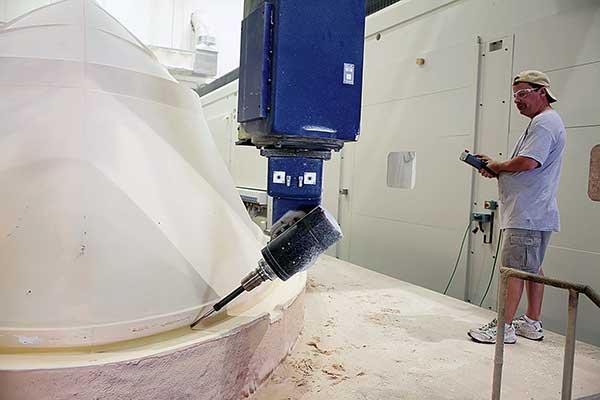
One of three five-axis milling machines at Sykes Creek precisely creates the form that will become the "master." Once faired by hand, the master is the male shape from which the tooling is created. All new hulls are laid up inside that tooling. (Photo: Sea Ray)
"Twenty years ago," said Berman, "we'd mill hulls and decks and big parts but build smaller parts by hand. Today, we mill everything. The mill's precision gives us an ability to get far more mature designs in fiberglass." Berman estimates that Sea Ray probably has a quarter of the tooling mill capacity for the marine industry in North America. Builders whose scale doesn't justify the investment in CNC milling machines can contract with companies that specialize in tooling: Marine Concepts, Symmetrix, Janicki, and others. Composites expert JP Mouligné is a senior account manager at Gurit, which supplies materials and services to composites builders in several industries, including boatbuilding. "As a tendency," Mouligné said, "we're seeing fewer companies doing their own tooling."
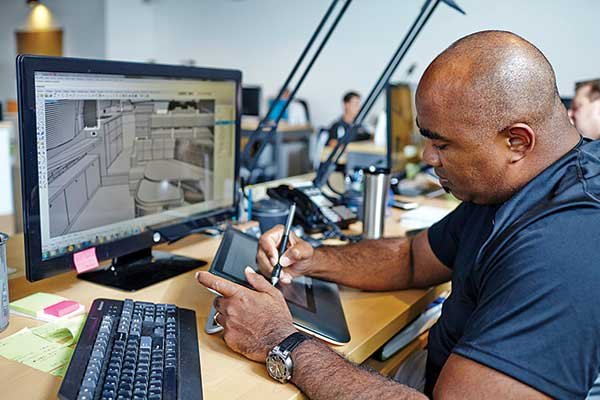
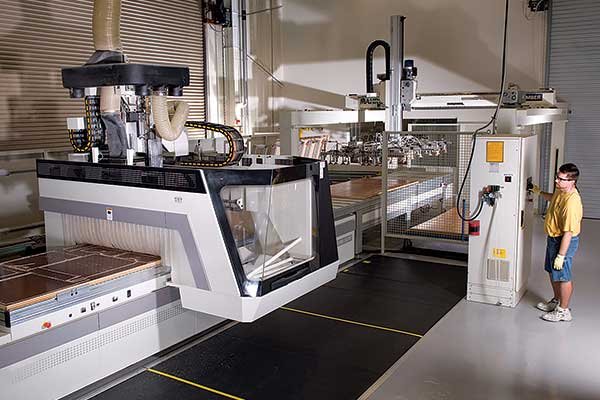
Using CAD programs, designers achieve astonishing detail: colors and textures of upholstery and furniture, precise hose and wire runs, detailed systems installation. These instructions are sent directly to CNC routers to create the parts from which the final boat is assembled. (Photos: Sea Ray)
If you've ever owned or worked on a boat whose port and starboard sides aren't symmetrical, you can appreciate the precision of a CNC-milled master, which creates drawers and hatches that fit well, propulsion drive gear that aligns, and doors that open and close without sticking. The same work flow applies to a boat's furniture. A designer creates a cabinet for a refrigeration unit, including particular veneers, thicknesses, and fastener methods. Plumbing and electrical designers come in next to lay out hose and wire runs. When the model is finished, it gets turned into digital CNC files that are sent to the milling machine. "And then," said Sea Ray's Berman, "the first set of parts can be cut precisely with a router instead of a tape measure and saws," eliminating the "Friday Boat" risk of mismatched parts that might have been assembled by someone having a bad day.
Hand-Laid Fiberglass-Reinforced Plastic
Composite boatbuilding is 75-year-old technology. Glass fiber made its first appearance in 1931. DuPont created polyester resin in 1936. In 1941, the first modern composite boat was built. FRP building methods became standard on an ever-larger scale through the 1960s. Certain basic materials and practices constituted technology in which builders have developed confidence. These include glass fibers and polyester resins, laid up by hand in an open mold. But progressive builders have introduced added innovations in technique and new materials.
Vinylester, PVC Foam Cores, Carbon Fiber
Here's an example where, for modern builders, slightly newer materials and techniques are edging out older ones. Sea Ray has moved to vinylester resin — a 1980s technology, and more expensive than 1940s-era polyester resin — for the outer layers in its hulls because it better resists osmotic blistering. In today's Sea Rays, PVC foam core (an early 1970s technology) replaces balsa core (a late 1950s technology) because foam core resists water migration and delamination better than balsa. Sea Ray recently introduced carbon fiber in the laminate for some of its larger hard tops, making a structure so stiff that the builder is able to eliminate stainless-steel supports, saving weight up high. This gives its boats a lower center of gravity, and therefore a more comfortable ride. In 1994, Hinckley, in Maine, began using Kevlar in its first Picnic Boat hulls; the decade-old Talaria line incorporates carbon fiber — for more strength, and less weight, hence better performance. High-end builders, such as Scout, in South Carolina, and MJM (Boston Boatworks), in Massachusetts, and premium custom shops build with epoxy, a resin whose properties are better still than vinylester in terms of strength, weight, color-retention, and resistance to water intrusion.
Resin Infusion and Resin Transfer
The vast majority of composite boats on the water today were built with hand-layup techniques. This method presented builders with two challenges: it releases toxic compounds into the air, and the parts may have too much or too little resin. Too much makes it heavier than necessary for needed strength; too little makes it too weak. But hand layup can be done relatively quickly, which is important for builders who turn out many boats a day. Today's newer "closed molding" technologies, however, though initially more time-consuming and expensive, minimize the amount of resin in the laminate and more thoroughly and evenly distribute the resin throughout the laminate, thereby making a lighter, stronger hull. According to JP Mouligné, Tillotson-Pearson Inc., in Rhode Island, infused the first hull in the early '90s, a Sundeer 56 sailboat. Among powerboat builders, Viking Yachts, in New Jersey, has been infusing hulls this way for several years and now uses the technique for just about all its models. Intrepid, in Florida, which has infused smaller parts for years, recently launched an ad campaign touting its first infused hull, a 327.
With resin infusion, all the fibers and core are stacked dry, then sealed with an airtight plastic cover. Manifolds and tubing must be run to injection points all over the hull or deck, taking prep time. Then, vacuum pressure draws the resin evenly through the structure. Believe it or not, once the taps are turned on over at Viking, for instance, the vacuum pumps can infuse a 92-foot hull in just 90 minutes.
As an added benefit, in cored structures, the vacuum pressure draws resin into the scored cutouts in the foam, eliminating air gaps. Sea Ray infused its first hull, a 510 Fly, in late 2015, just after our visit, and estimated the process would save 2,500 pounds in the hull alone, which will directly improve the boat's performance and fuel efficiency.
Resin-transfer molding, or RTM, is another closed-molding technique. European boatbuilders, driven by strict emissions limits, were early adopters of this technology. "Beneteau has been a fascinating company from a technology point of view," said Richard Downs-Honey, head of business development at Gurit. "They moved past the simple single-bag infusion a long time ago into double molds for their decks, so they come out glossy inside and out."
This technology is a closed-molding process. Unlike infusion, it requires two molds, top and bottom. The fibers are stacked, the molds are fitted together, and resin is forced into the laminate under positive pressure. Building two molds makes this method expensive. But in addition to the environmental upsides, it creates an advantage: an FRP part with two gelcoat-finished sides. Sea Ray has recently begun using RTM to build some of its parts, but not yet hulls or decks.
Robotics and Modern Management
Perhaps it is here, in innovative new ways that improve the actual step-by-step building of the boats, that modern technology has introduced one of its most impressive changes.
Enter the Robots!
Sea Ray builds its smaller boats at its Tellico campus in Tennessee. "We have robots that do many different things," said Matt Guilford, Sea Ray's VP of marketing. At the initial layup stage, robots spray gelcoat into the tooling. They're fast and accurate, spraying the same designed thickness every time.
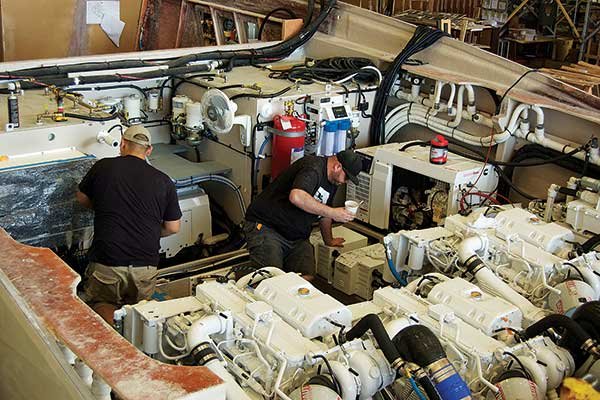
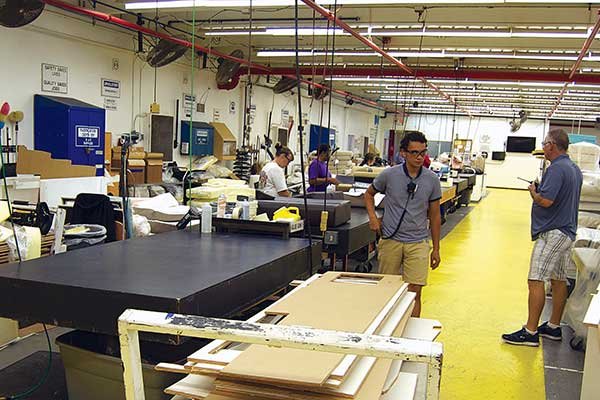
At the assembly phase, technicians work to accurate designs provided on digital monitors on the shop floor and tablets at work stations. All upholstery is cut and created from the CAD designs. (Photos: Sea Ray)
With pinpoint accuracy, robots in the cutting booth work with tolerances of 1/8,000ths of an inch. More traditional practice would be for boatbuilders to cut holes and drill and tap by hand, or use jigs or templates, as opposed to a computer-controlled five-axis router that can cut a perfect transom hole for a sterndrive, eliminating concerns about alignment or leaky mismatches.
Production Management
Today's most-successful large boatbuilders have adopted modern management systems used in other industries. Sea Ray, for instance, has adapted the "Lean Six Sigma" and "Line Balancing" methods to methodically eliminate waste, better manage workers and their jobs, and efficiently correlate work and material when changes are needed.
Digital monitors are used throughout the building process, displaying lists of every action a construction team needs to complete, plus installation guides and instruction videos. Tablets carry the same information directly to the work space. One "pass/fail" example we observed at Sea Ray showed two side-by-side photos of installations. In the "pass" image, a hose was installed so that it self-drained; in the "fail" image, fluid would have collected in an unwanted loop. Line workers see the difference in real time as they assemble systems; managers catch faulty installations before the boat moves down the line.
Upward of 10,000 discrete tasks go into building a 65-foot Sea Ray. "We build as much as we can outside the boat in modular fashion so it's easier for the assembly line to pick the component up and fit it in," said Dan Robinson, Sea Ray's director of manufacturing operations. "They drop them in like Legos."
Finally, quality checks are conducted at stations all along the line with one person's name validating each item. When Sea Rays leave the assembly space, they're submitted to an on-the-water test of several hours, and finally the "hurricane test": 2,700 gallons of water flooding down on the boat in an hour. Two leaks were identified — and immediately fixed — on a boat we watched being tested.
Boats for Today
So much for process and production. Now let's look at new technology in the boats themselves, starting with propulsion. Typically, larger pleasure boats 20 years ago were powered by inboard engines or sterndrives. Outboard engines were gas-guzzling two-strokes, and the biggest outboards available were less than 200 horsepower.
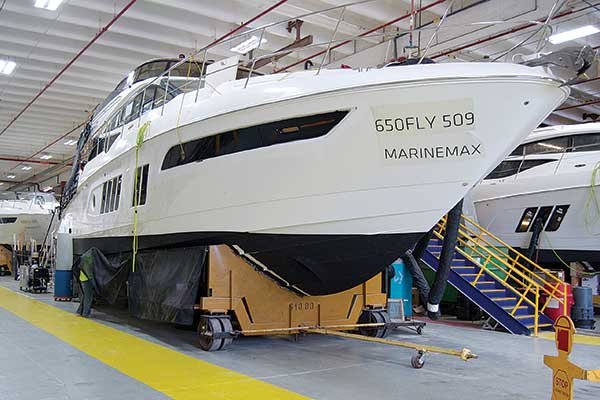
At Sea Ray's Palm Coast campus, a 650 Fly is going through its final assembly phase — a process that includes some 10,000 discrete tasks. (Photo: Sea Ray)
"Probably the biggest thing that's happened in 20 years is outboard technology," said Sea Ray's Ron Berman, particularly with four-stroke engines, which bring state-of-the-art technology in digital shifting and joystick docking. And most significantly for coastal boaters, they avoid the corrosion problems of a lower end left in saltwater.
Then there are the bells and whistles in the boats of today — integrated chartplotters, Zeus pods, joystick docking and automatic station-keeping for diesel-powered boats, Wi-Fi networks, lighter retractable hardtops, and so on. These fun and helpful developments, joined with all the design and building refinements in play at state-of-the-art builders, have created well-built innovative boats designed to perform better, accommodate people more comfortably, and deliver better integrated features, all at a more competitive price than was dreamed possible decades ago.
Innovation At Beneteau
Groupe Beneteau has been building boats for 30 years in America and 130 years in France, and last year generated $1.06 billion in sales. Since 2010, Beneteau's production and sales have shifted dramatically from sailboats to powerboats.
"In America," said Beneteau USA president Laurent Fabre, "we only started selling powerboats five years ago, and already it's 50 percent of our production." In August 2014, Beneteau acquired Michigan-based Rec Boat Holdings (Four Winns, Glastron, Wellcraft, Scarab). The company has built Beneteau-brand trawlers at its South Carolina plant and plans to increase powerboat production there. Meanwhile, the company has invested heavily in new technology in both its products and its processes. It emerged from the 2008–09 financial crisis with the innovative Sense line of sailboats, and the Dock & Go joystick control of the engines.
The company's approach to hull form illustrates how its in-house designers worked with partners outside the company to create its patented Air Step underbody — particularly engineer Rémi Laval-Jeantet, whose fluid-dynamics résumé includes windmills, ballistic missiles, and silent submarine propellers, and with a partner school of naval architecture in Nantes, France, which provides tank testing. In the Air Step design, chines are inverted from their traditional orientations to direct air under the boat, down the center line, while keeping the wet surfaces along the side of the boat, which includes two skegs. The result? "When you make a turn," said Fabre, "the boat cannot roll out. You have fine control. The air gives strong lift to the boat." The advantages are lower fuel consumption, faster acceleration, and higher top speed.
Almost simultaneously, Volvo brought out its innovative IPS propulsion leg. "From the beginning," said Fabre, "we worked closely with Volvo to make sure our Air Step worked with their IPS." Their initial concerns were whether air under the boat would introduce turbulence and negate the advantages of the IPS system; and whether the mix of air and water would accelerate corrosion on the IPS leg. To prove the system, Beneteau built a complete prototype of its GT 46 and tested it with Volvo for 400 hours over six months. "The two systems are fully compatible," said Fabre. See our magazine's cover this month for an artist's rendition of how the Air Step works with the boat's propulsion system to add lift.
Introducing Mister Green
A byproduct of boatbuilding is the release of Volatile Organic Compounds, better known as VOCs. These organic compounds easily evaporate into the air (hence they're "volatile") and are regulated at many bureaucratic levels, including federal air-quality standards and indoor air standards. If you grew up using oil-based paints in your house and remember when water-based latex paints began to be used, you were witnessing a move away from solvents and the VOCs they contained. There are many sources of VOCs in industrial applications, but you're probably very familiar with the resins used to make fiberglass boats and the paint and finishes used on boats. Bottom paint in particular is going through a revolution right now, with the introduction of water-based paints.
Solving The Solvent Issue
Chances are you remember, with some distaste, the last time you painted your boat's bottom. It's a messy, uncomfortable process for many of us, but with new, water-based anti-fouling paints, such as Hydrocoat from Pettit and Micron Optima from Interlux, you've gone from a paint that could eat through a roller to ones that clean up with soap and water. These low-odor paints feature dramatically lower VOCs, often a reduction of more than 50 percent, compared with paints with traditional solvents, so you can even paint indoors in some circumstances. It should be noted these are still multi-season ablative paints. Once dried, they are no different than traditional paints. In fact, you can apply them right over your old paint.
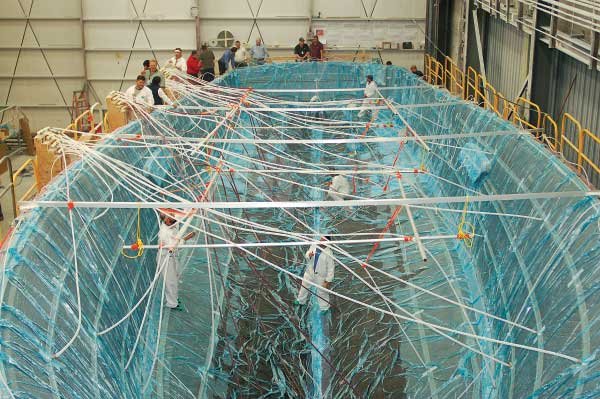
Notice the absence of respirators on this Viking work crew? The modern vacuum-bagging (sealed) process means no harsh compounds escape into the air. Note, too, the red arteries of resin flowing directly to dozens of entry points in the hull. (Photo: Viking Yachts)
By switching to using water as a solvent, instead of harsher (and regulated) solvents, bottom-paint manufacturers are preserving your ability to continue to paint your own hull.
Closed Molding Is The New Black
In the not-so-distant future, closed-molding techniques, like vacuum bagging, will be the standard across the boatbuilding industry, at least for builders of any significant volume. Some VOCs cause smog and other serious problems. Therefore they are regulated at the federal level. But poor air quality isn't equally distributed across the country. If you live in the Northeast, your air is already subject to strict scrutiny. Ditto California, or in parts of Texas. But eventually, the gradual tightening of regulations regarding toxins will impact the whole country.
"There will come a day where every drop of resin a builder brings into the plant will need to be accounted for, whether it goes into a boat or is spilled on the floor," says Peter Frederiksen of Viking Yachts. The New Jersey-based builder of sportfish yachts vacuum-bags just about every hull already, even their 92-footer (left). And while the prep for vacuum bagging — the time required to lay up the materials that will go into the hull, seal the mold under plastic, run the hoses, hook up the manifolds, and attach vacuum pumps — seems quite involved, there are a lot of benefits. First, the plant has less odor and harmful chemicals in the air. Second, the precise metering of resin means the right amount is always used throughout. Not too much, which adds unnecessary weight, nor too little, which can make the hull brittle. And the vacuum pressure virtually eliminates voids, those hidden places where no resin flows into the fiberglass. These things mean a better boat. Plus, of course, allowing the resin to set under seal prevents those VOCs from escaping.
— Michael Vatalaro
BoatUS Members save at Boat Shows
Make sure to mark your calendars for two exciting events – the New England Boat Show, Chicago Boat Show, and Atlanta Boat Show. Don’t miss out on these incredible shows! BoatUS Members save 25% with code BOATUS25.
Here are the dates for each show:
